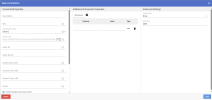Settings for GraphQL
This topic describes how to set up an GraphQL connection for DataSync.15977
To configure a new connection:
-
In DataSync, create a new source connection for GraphQL.
-
Fill out the fields in the Connection Properties panel as well as the fields described below.
-
Click Save.
| Additional Connection Properties | Description |
|---|---|
| HTTP Headers |
For some API, Custom HTTP headers need to be include as part of API request.
|
| ExpandTablesDepth |
|
